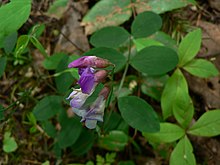
Lathyrus is a genus of flowering plants in the legume family Fabaceae, and contains approximately 160 species. Commonly known as peavines or vetchlings, they are native to temperate areas, with a breakdown of 52 species in Europe, 30 species in North America, 78 in Asia, 24 in tropical East Africa, and 24 in temperate South America. There are annual and perennial species which may be climbing or bushy. This genus has numerous sections, including Orobus, which was once a separate genus.
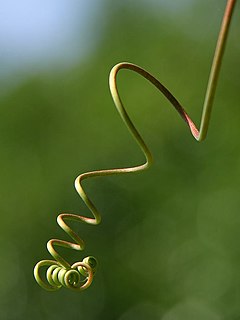
In botany, a tendril is a specialized stem, leaf or petiole with a threadlike shape used by climbing plants for support and attachment, as well as cellular invasion by parasitic plants such as Cuscuta. Tendrils are responsive to touch and to chemical factors by curling, twining, or adhering to suitable structures or hosts.

Lathyrus latifolius, the perennial peavine, perennial pea, broad-leaved everlasting-pea, or just everlasting pea, is a robust, sprawling herbaceous perennial flowering plant in the pea family Fabaceae. It is native to Europe but is present on other continents, such as North America and Australia, where it is most often seen along roadsides.

Lathyrus pratensis or meadow vetchling, yellow pea, meadow pea and meadow pea-vine, is a perennial legume that grows to 1.2 m in height.

Lathyrus japonicus, the sea pea, beach pea, circumpolar pea or sea vetchling, is a species of flowering plant in the legume family Fabaceae, native to temperate coastal areas of the Northern Hemisphere and Argentina.

Lathyrus tuberosus is a small, climbing perennial plant, native in moist temperate parts of Europe and Western Asia. The plant is a trailer or weak climber, supported by tendrils, growing to 1.2 m tall. The leaves are pinnate, with two leaflets and a branched twining tendril at the apex of the petiole. Its flowers are hermaphroditic, pollinated by bees. The plants can also spread vegetatively from the root system.
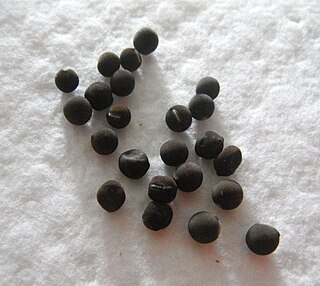
The sweet pea, Lathyrus odoratus, is a flowering plant in the genus Lathyrus in the family Fabaceae (legumes), native to Sicily, southern Italy and the Aegean Islands.

Lewisia is a plant genus, named for the American explorer Meriwether Lewis (1774-1809) who encountered the species in 1806. The native habitat of Lewisia species is north facing cliffs in western North America. Local Native Americans ate the roots, which have also been used to treat sore throats.
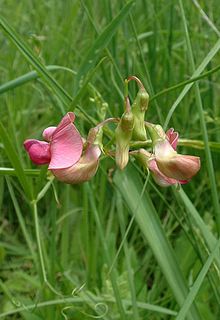
Lathyrus sylvestris, the flat pea or narrow-leaved everlasting-pea, is a plant species of the genus Lathyrus. It is native to parts of Africa, Europe, and Asia.
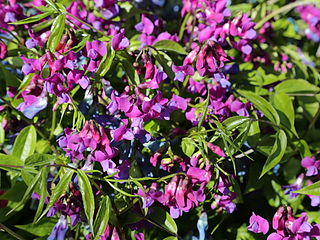
Lathyrus vernus, the spring vetchling, spring pea, or spring vetch, is a species of flowering herbaceous perennial plant in the genus Lathyrus, native to forests of Europe and Siberia. It forms a dense clump of pointed leaves with purple flowers in spring, shading to a greenish-blue with age.
Lathyrus jepsonii is a species of wild pea known by the common names delta tule pea and Jepson's pea. It is endemic to California, where it grows in a number of habitat types, including forest and estuary.

Lathyrus palustris is a species of wild pea known by the common name marsh pea. It is native to Europe, Asia, and North America. It is a perennial herb with leaves made up of oval-shaped or oblong leaflets a few centimeters long. It has branched, coiled tendrils. The plant bears an inflorescence of two to eight pinkish purple pea flowers each up to two centimeters wide. The fruit is a dehiscent legume pod.
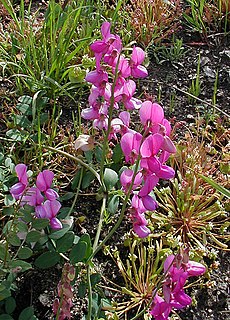
Lathyrus vestitus is a species of wild pea known by the common name Pacific pea. It is native to western North America, where it is mostly found in the forests, woodlands, and chaparral of California. The ranges of some subspecies extend into Oregon and Baja California. This is a perennial pea vine which varies in appearance across subspecies. Leaves are made up of several leaflets of various shapes up to 4 or 5 centimeters long. The leaves usually bear coiling tendrils and the stipules may be large or small. The inflorescence is a showy array of up to 15 pea flowers, sometimes densely packed together, and usually some shade of light to medium purple or white.

A crop wild relative (CWR) is a wild plant closely related to a domesticated plant. It may be a wild ancestor of the domesticated (cultivated) plant, or another closely related taxon.
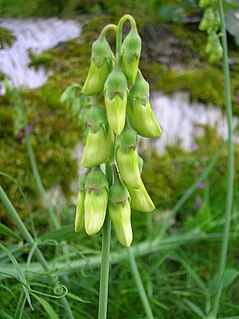
Lathyrus linifolius is a species of pea, commonly called bitter vetch or heath pea. The name bitter vetch is also sometimes used for Vicia ervilia and also for Vicia orobus. The tubers of Lathyrus linifolius were formerly used as an appetite suppressant in medieval Scotland, and this use has brought the plant to recent medical attention. Attempts are being made to cultivate the plant on a commercial scale.

Charles Leo Hitchcock was an American botanist. He discovered 20 species of plants and his works have been cited thousands of times. He is also the primary co-author to the Flora of the Pacific Northwest, still the most up to date flora for three northwest U.S. States to date. A hall at the University of Washington is named in his honor, and he taught thousands of botanists over the course of his teaching career at the University of Washington.
Ira Waddell Clokey (1878-1950) was an American mining engineer and botanist active in the western United States. He first studied at the University of Illinois, then moved to Harvard University, graduating with a Bachelor of Science in mining engineering in 1903. From 1904 to 1915, Clokey worked as a mining engineer in Mexico. In his spare time he collected plant specimens for his personal herbarium, which, however, was almost completely destroyed during a fire in 1912. In 1921, Clokey completed a Master of Science in plant pathology from Iowa State University.
Charles Stewart Parker was head of the Department of Botany at Howard University. He carried out the first systematic study of American species of the fungal genus Hypholoma and also collected over 2000 plant specimens, including several new species.
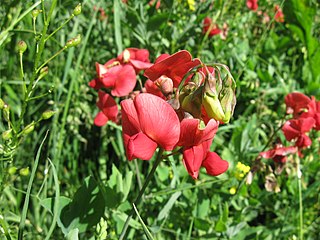
Lathyrus rotundifolius, the Persian everlasting pea, is a species of flowering plant in the pea family Fabaceae, native to Turkey. Growing to 1.5 m (4.9 ft) tall, this herbaceous perennial climber has twining, clinging tendrils and brick red flowers in summer. Unlike its relative, the sweet pea, the flowers are unscented. It is hardy to −20 °C (−4 °F), but requires a position in full sun.
